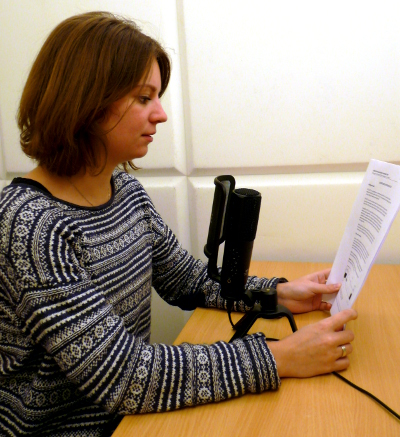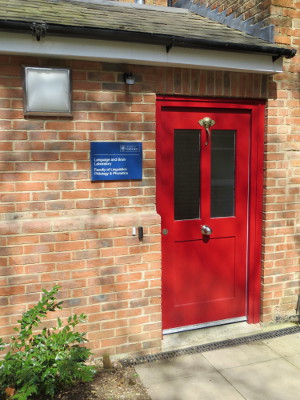
The Language & Brain laboratory provides special-purpose facilities and equipment for conducting a variety of behavioural and neurolinguistic experiments, as well as high-quality voice recording.
It also houses the "Tiger's Den" room for tutorials, and office space for the Lab Manager, Postdoctoral Researchers, and a number of DPhil students working in psycholinguistics and neurolinguistics under the supervision of Professor Aditi Lahiri and Professor Matt Husband.
Neurolinguistics Lab
The Neurolinguistics lab is equipped with two state of the art RF shielded audiology booths designed for high-quality EEG recordings to give the cleanest possible data, enabling us to run two different experiments simultaneously.
Each booth contains two adjustable height TV screens for experimental setup and the presentation of visual stimuli, a pair of Tannoy speakers (or a choice of headphones) for auditory stimuli, and comfortable seating to ensure that our participants can relax and enjoy the experience as much as possible.
During the EEG recordings, in some experiments the participant may be asked to press a button to signify that they have read or heard a "non-word", for example. In another type of experiment, the participant may be asked to speak and name the objects shown in a series of pictures or photographs. Sometimes the participant may just listen to word sounds whilst we record their EEG. In fact, our equipment enables us to conduct a wide variety of different experiments in almost any language to suit the specific research project.
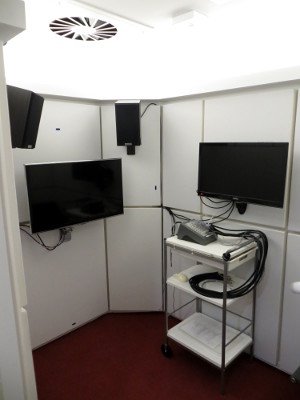
We have experience of using two different systems for our EEG recordings:
- A low-impedance (< 5K ohms) passive electrode system from ANT that can record 65 simultaneous EEG channels
- A high-impedance (300M ohms) active electrode system from BioSemi that can record 64 EEG and 8 facial / EMG electrode channels
The photograph below shows a typical test session using our BioSemi active electrode EEG system with one of our DPhil students volunteering as participant!
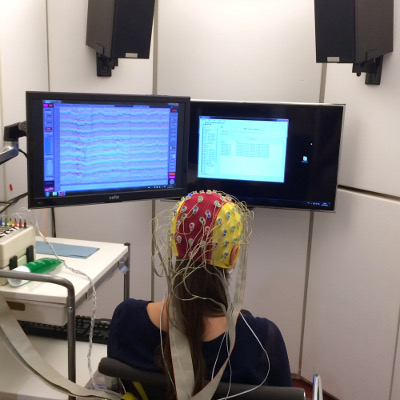
In this photo, the left-hand monitor is displaying the brain wave signals in real-time to assist set-up, and the monitor in front of the participant is showing various system settings prior to running the actual experiment.
When an experiment is being run, the left-hand monitor is switched off and moved away, and the required visual stimuli (e.g. words, pictures, etc) are presented on the monitor directly in front of the participant.
The participant may also listen to auditory stimuli (e.g. spoken words or other sounds) played through the speakers or, more frequently, on headphones.
Speech Recording Lab
Our speech recording booth allows us not only to record high-quality audio stimuli for our experiments, but also to run production studies which involve recording the time taken for someone to plan an utterance.
The latest USB studio microphones make it very straightforward to capture good quality speech recordings directly on a laptop computer as ".wav" files for subsequent editing or analysis, etc.
Eyetracking Lab
Eye tracking is the measurement of eye movement & eye position due to stimuli and is used in research areas as diverse as psycho- and cognitive linguistics and psychology, oculomotor research and the visual system. Examples include the study of reading processes, speech production and language comprehension, face and motion perception, and hand-eye coordination.

Our state-of-the-art SR Research Eyelink1000 eye tracker can be used on its own, or in combination with our EEG equipment. We use Experiment Builder and Data Viewer software packages to enable the quick and easy implementation of complex trials; other software options include Presentation, E-Prime and Matlab.
Psycholinguistics Lab
Our psycholinguistics lab is equipped with bespoke hardware and software to run behavioural experiments (e.g. lexical decision tasks or timed forced choice experiments) across different modalities. We can currently run eight participants at the same time at individually screened desks.
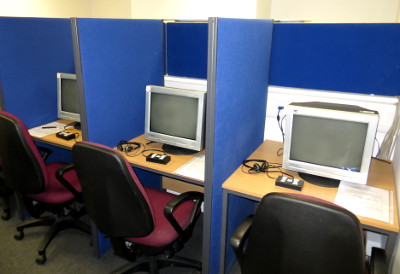
The special hardware is transportable and can be used to run a maximum of 16 participants at any one time. We have already used it in other locations in Oxford and the UK, as well as in Germany, Norway and India.
